Epson PowerLite 824PLUS, PowerLite 825PLUS, PowerLite 826WPLUS, PowerLite 84PLUS, PowerLite 85PLUS User Manual
PowerLite®
84+/85+/824+/825+/826W+
Multimedia Projector
User’s Guide

Important Safety Information
WARNING: Never look into the projector lens when the lamp is turned on; the bright light can damage your eyes. Never let children look into the lens when it is on. Never open any cover on the projector, except the lamp and filter covers. Dangerous electrical voltages inside the projector can severely injure you. Except as specifically explained in this User’s Guide, do not attempt to service this product yourself. Refer all servicing to qualified service personnel.
WARNING: The projector and its accessories come packaged in plastic bags. Keep plastic bags away from small children to avoid any risk of suffocation.
Caution: When you replace the lamp, never touch the new lamp with your bare hands; the invisible residue left by the oil on your hands may shorten the lamp life. Use a cloth or glove to handle the new lamp.
Copyright Notice
All rights reserved. No part of this publication may be reproduced, stored in a retrieval system, or transmitted in any form or by any means, electronic, mechanical, photocopying, recording, or otherwise, without the prior written permission of Seiko Epson Corporation. The information contained herein is designed only for use with this Epson product. Epson is not responsible for any use of this information as applied to other products.
Neither Seiko Epson Corporation nor its affiliates shall be liable to the purchaser of this product or third parties for damages, losses, costs, or expenses incurred by purchaser or third parties as a result of: accident, misuse, or abuse of this product or unauthorized modifications, repairs, or alterations to this product, or (excluding the U.S.) failure to strictly comply with Seiko Epson Corporation’s operating and maintenance instructions.
Seiko Epson Corporation shall not be liable for any damages or problems arising from the use of any options or any consumable products other than those designated as Original Epson Products or Epson Approved Products by Seiko Epson Corporation.
Trademarks
Epson, EasyMP, and Instant Off are registered trademarks, and Epson Exceed Your Vision is a registered logomark of Seiko Epson Corporation.
PowerLite and PrivateLine are registered trademarks, Duet and SizeWise are trademarks, and Extra Care is a service mark of Epson America, Inc.
Pixelworks, DNX, and the DNX logo are trademarks of Pixelworks, Inc.
General Notice: Other product names used herein are for identification purposes only and may be trademarks of their respective owners. Epson disclaims any and all rights in those marks.
This information is subject to change without notice.
© 2009 Epson America, Inc. |
12/09 |
CPD-27783
2

C-Contents
Welcome . . . . . . . . . . . . . . . . . . . . . . . . . . . . . . . . . . . . . . 7
Using Your Documentation . . . . . . . . . . . . . . . . . . . . . . . . . . 8
Getting More Information . . . . . . . . . . . . . . . . . . . . . . . . 9
Registration and Warranty . . . . . . . . . . . . . . . . . . . . . . . . . . . 9
Unpacking the Projector. . . . . . . . . . . . . . . . . . . . . . . . . . . . 10
Projector Parts . . . . . . . . . . . . . . . . . . . . . . . . . . . . . . . . . . . 11
Additional Components . . . . . . . . . . . . . . . . . . . . . . . . . . . . 12
Optional Accessories. . . . . . . . . . . . . . . . . . . . . . . . . . . . . . . 13
|
Displaying and Adjusting the Image . . . . . . . . |
15 |
1 |
Positioning the Projector . . . . . . . . . . . . . . . . . . . . . . . . . . . |
16 |
|
Turning the Projector On and Off . . . . . . . . . . . . . . . . . . . . |
22 |
|
Turning On the Projector . . . . . . . . . . . . . . . . . . . . . . . |
23 |
|
Using the Direct Power On Function . . . . . . . . . . . . . . |
24 |
|
Shutting Down the Projector . . . . . . . . . . . . . . . . . . . . . |
25 |
|
Selecting the Image Source . . . . . . . . . . . . . . . . . . . . . . . . . . |
25 |
|
Adjusting the Image . . . . . . . . . . . . . . . . . . . . . . . . . . . . . . . |
26 |
|
Adjusting the Height of Your Image . . . . . . . . . . . . . . . |
27 |
|
Focusing and Zooming Your Image . . . . . . . . . . . . . . . . |
27 |
|
Adjusting the Image Shape. . . . . . . . . . . . . . . . . . . . . . . |
28 |
|
Correcting Computer Images. . . . . . . . . . . . . . . . . . . . . |
30 |
3

|
Using the Remote Control . . . . . . . . . . . . . . . . . . . |
31 |
2 |
Using the Remote Control . . . . . . . . . . . . . . . . . . . . . . . . . . |
32 |
|
Replacing the Batteries. . . . . . . . . . . . . . . . . . . . . . . . . . |
32 |
|
Controlling the Picture and Sound. . . . . . . . . . . . . . . . . . . . |
33 |
|
Switching Between Picture Sources . . . . . . . . . . . . . . . . |
33 |
|
Turning Off the Picture and Sound . . . . . . . . . . . . . . . . |
34 |
|
Stopping Action. . . . . . . . . . . . . . . . . . . . . . . . . . . . . . . |
34 |
|
Zooming Part of Your Image . . . . . . . . . . . . . . . . . . . . . |
35 |
|
Controlling the Volume. . . . . . . . . . . . . . . . . . . . . . . . . |
35 |
|
Adjusting the Aspect Ratio. . . . . . . . . . . . . . . . . . . . . . . |
36 |
|
Adjusting the Color Mode . . . . . . . . . . . . . . . . . . . . . . . |
38 |
|
Displaying Patterns . . . . . . . . . . . . . . . . . . . . . . . . . . . . . . . |
39 |
|
Assigning a Pattern to the User Button . . . . . . . . . . . . . |
39 |
|
Creating Your Own Pattern . . . . . . . . . . . . . . . . . . . . . . |
40 |
|
Operating Your Computer with the Remote Control . . . . . . |
41 |
|
Highlighting Your Presentation . . . . . . . . . . . . . . . . . . . . . . |
42 |
|
Using the Pointer Tool . . . . . . . . . . . . . . . . . . . . . . . . . |
42 |
|
Customizing the Pointer Tool . . . . . . . . . . . . . . . . . . . . |
42 |
|
Presenting a Slideshow . . . . . . . . . . . . . . . . . . . . . . . . . . . . |
43 |
|
Starting a Slideshow. . . . . . . . . . . . . . . . . . . . . . . . . . . . |
44 |
|
Selecting Slideshow Display Options . . . . . . . . . . . . . . . |
46 |
|
Connecting to Computers, USB Devices, and |
|
3 |
Other Equipment. . . . . . . . . . . . . . . . . . . . . . . . . . . . |
47 |
|
Connecting to a Computer. . . . . . . . . . . . . . . . . . . . . . . . . . |
48 |
|
Connecting to the VGA Port . . . . . . . . . . . . . . . . . . . . . |
49 |
|
Connecting to the USB Port . . . . . . . . . . . . . . . . . . . . . |
50 |
|
Connecting the USB Cable for Remote Mouse Control 51 |
|
|
Connecting an External Monitor . . . . . . . . . . . . . . . . . . |
53 |
|
Connecting to Video Equipment . . . . . . . . . . . . . . . . . . . . . |
54 |
|
Connecting a Composite Video Source . . . . . . . . . . . . . |
54 |
|
Connecting an S-Video Source . . . . . . . . . . . . . . . . . . . |
55 |
|
Connecting a Component Video Source . . . . . . . . . . . . |
56 |
|
Connecting an RGB Video Source. . . . . . . . . . . . . . . . . |
57 |
|
Connecting to a Digital Camera, Document Camera, |
|
|
or Other Device. . . . . . . . . . . . . . . . . . . . . . . . . . . . . . . |
58 |
4

|
Playing Sound Through the Projector. . . . . . . . . . . . . |
. . . . . 59 |
|
Playing Computer Audio . . . . . . . . . . . . . . . . . . . |
. . . . . 59 |
|
Playing Sound from Video Equipment. . . . . . . . . |
. . . . . 60 |
|
Connecting a Microphone . . . . . . . . . . . . . . . . . . |
. . . . . 60 |
|
Connecting External Speakers . . . . . . . . . . . . . . . |
. . . . . 61 |
|
Using the Projector on a Network . . . . . . |
. . . . . 63 |
4 |
Connecting to a Wired Network . . . . . . . . . . . . . . . . |
. . . . . 64 |
|
Installing the Optional Wireless 802.11a/b/g Module |
. . . . . 67 |
|
Using Quick Wireless Connection . . . . . . . . . . . . . . . |
. . . . . 68 |
|
Configuring Basic Settings . . . . . . . . . . . . . . . . . . . . . |
. . . . . 69 |
|
Configuring the Connection. . . . . . . . . . . . . . . . . . . . |
. . . . . 71 |
|
Using Ad Hoc Mode . . . . . . . . . . . . . . . . . . . . . . |
. . . . . 71 |
|
Using Access Point Mode. . . . . . . . . . . . . . . . . . . |
. . . . . 78 |
|
Using Wireless Security Options. . . . . . . . . . . . . . . . . |
. . . . . 88 |
|
Enabling WEP Encryption. . . . . . . . . . . . . . . . . . |
. . . . . 89 |
|
Enabling WPA Security . . . . . . . . . . . . . . . . . . . . |
. . . . . 91 |
|
Enabling Data Encryption from EasyMP Network |
|
|
Projection . . . . . . . . . . . . . . . . . . . . . . . . . . . |
. . . . . 92 |
|
Using the EasyMP Network Projection Software . . . . . |
. . . . 93 |
|
Removing the Wireless 802.11a/b/g Module . . . . . . . . |
. . . . 93 |
|
Using Projector E-mail Alerts . . . . . . . . . . . . . . . . . . . . |
. . . . 94 |
|
Using SNMP to Monitor the Projector. . . . . . . . . . . . . |
. . . . 96 |
|
Using a Browser to Control the Projector . . . . . . . . . . . |
. . . . 97 |
|
Using Web Remote Control. . . . . . . . . . . . . . . . . . |
. . . . 99 |
|
Fine-Tuning the Projector. . . . . . . . . . . . . . . |
. . . 101 |
5 |
Using the Menu System . . . . . . . . . . . . . . . . . . . . . . . . |
. . . 102 |
|
Restoring the Default Settings . . . . . . . . . . . . . . . . |
. . . 103 |
|
Adjusting the Image . . . . . . . . . . . . . . . . . . . . . . . . . . . |
. . . 104 |
|
Adjusting Signal Settings . . . . . . . . . . . . . . . . . . . . . . . |
. . . 106 |
|
Customizing Projector Features . . . . . . . . . . . . . . . . . . |
. . . 108 |
|
Using the Projector Security Features . . . . . . . . . . . . . . |
. . . 110 |
|
Enabling Password Protection . . . . . . . . . . . . . . . . |
. . . 111 |
|
Creating Your Own Startup Screen . . . . . . . . . . . . |
. . . 114 |
|
Disabling the Projector’s Buttons . . . . . . . . . . . . . . |
. . . 115 |
|
Customizing Power and Operation. . . . . . . . . . . . . . . . |
. . . 116 |
5

|
Maintaining the Projector. . . . . . . . . . . . . . . . . . |
119 |
6 |
Cleaning the Lens. . . . . . . . . . . . . . . . . . . . . . . . . . . . . . . . |
120 |
|
Cleaning the Projector Case . . . . . . . . . . . . . . . . . . . . . . . . |
120 |
|
Cleaning the Air Filter and Vent . . . . . . . . . . . . . . . . . . . . |
121 |
|
Replacing the Lamp and Air Filter . . . . . . . . . . . . . . . . . . . |
122 |
|
Replacing the Lamp . . . . . . . . . . . . . . . . . . . . . . . . . . . |
122 |
|
Replacing the Air Filter . . . . . . . . . . . . . . . . . . . . . . . . |
126 |
|
Resetting the Lamp Timer . . . . . . . . . . . . . . . . . . . . . . |
128 |
|
Transporting the Projector . . . . . . . . . . . . . . . . . . . . . . . . . |
129 |
|
Solving Problems . . . . . . . . . . . . . . . . . . . . . . . . . . . |
131 |
7 |
Using On-Screen Help . . . . . . . . . . . . . . . . . . . . . . . . . . . . |
132 |
|
Checking Projector Status . . . . . . . . . . . . . . . . . . . . . . . . . |
132 |
|
What To Do When the Lights Flash . . . . . . . . . . . . . . |
133 |
|
Viewing Lamp Usage and Other Information . . . . . . . |
135 |
|
Solving Projector Operation Problems . . . . . . . . . . . . . . . . |
135 |
|
Solving Problems with the Image or Sound . . . . . . . . . . . . |
136 |
|
Solving Network Problems . . . . . . . . . . . . . . . . . . . . . . . . . |
145 |
|
Solving Problems with the Remote Control . . . . . . . . . . . . |
148 |
|
Where to Get Help. . . . . . . . . . . . . . . . . . . . . . . . . . . . . . . |
149 |
|
Speak to a Support Representative . . . . . . . . . . . . . . . . |
149 |
A B C
Projector Installation . . . . . . . . . . . . . . . . . . . . . . . 151
Technical Specifications . . . . . . . . . . . . . . . . . . . . 153
Notices . . . . . . . . . . . . . . . . . . . . . . . . . . . . . . . . . . . . . . 159
Important Safety Instructions . . . . . . . . . . . . . . . . . . . . . . . 159
FCC Compliance Statement. . . . . . . . . . . . . . . . . . . . . . . . 163
Software Notices (for PowerLite 85+/825+/826W+) . . . . . 164
Index. . . . . . . . . . . . . . . . . . . . . . . . . . . . . . . . . . . . . . . . 193
6

W-Welcome
The PowerLite® 84+/85+/824+/825+/826W+ is an easy-to-use projector that weighs less than 7 pounds. From classrooms to boardrooms, your full-color presentations and videos will be bright and vibrant even in ordinary indoor lighting. You can connect the projector to a wide range of computers and video sources. With the PowerLite 85+/824+/825+/826W+, you can project from a USB storage device. With the PowerLite 85+/825+/826W+, you can project over your wired network or, with the optional Wireless 802.11a/b/g Module, you can project over an 802.11g, 802.11b, or 802.11a wireless network.
Easy setup, control, and security:
■8.5-second startup time and Instant Off ® feature for fast setup and shut down
■Automatic digital keystone correction
■Closed captioning
■1.6x optical zoom lens for flexible placement and positioning
■USB projection for quick and easy connection
■10 Watt speaker and microphone input
■Security features including password, user’s logo, security slot (for a Kensington MicroSaver® theft deterrent device), security bar (for a theft deterrent wire lock) and the ability to lock the projector buttons
■A/V Mute slide to temporarily turn off the image and sound, ideal for breaks or when you want to redirect your audience’s attention
■Project up to four different images from one computer (85+/825+/826W+ only)
7

■Project only the PowerPoint® slide images while viewing handout notes and controls on the computer screen (85+/825+/826W+ only)
■Project from a thumb drive or other USB storage device (85+/824+/825+/826W+ only)
■A Message Broadcasting plug-in (85+/825+/826W+ only) that allows you to project timely alerts and messages to all networked projectors (to download both the plug-in and its instructions, visit Epson’s support website at www.epson.com/support and select your product)
Using Your Documentation
This electronic User’s Guide provides detailed instructions on using your projector.
In addition, your projector CD-ROM may include the EasyMP Network Projection Operation Guide (85+/825+/826W+ only) and the EasyMP Monitor Operation Guide (84+/85+/825+/826W+ only). Refer to EasyMP Network Projection Operation Guide for detailed instructions on giving presentations over a network. Refer to the
EasyMP Monitor Operation Guide for detailed instructions on monitoring the projector from a remote location. To set up your projector for the first time on a network, see page 63 of this User’s Guide.
Please follow these guidelines as you read through this manual:
■Warnings must be followed carefully to avoid bodily injury.
■Cautions must be observed to avoid damage to your equipment.
■Notes contain important information about your projector.
■Tips contain additional projection hints.
8 Welcome

Getting More Information
Need troubleshooting tips? Quick steps for setting up your projector? Here’s where you can look for help:
■Quick Setup sheet
Gives you the instructions you need to get your projector up and running.
■Built-in help system
Provides assistance for common problems. Available from the ? Help button on the projector or the remote control. See
page 132 for details.
■epson.com/support
Download FAQs and e-mail your questions to Epson support.
■PrivateLine support
If you still need help after checking this User’s Guide and the sources listed above, you can use the Epson PrivateLine® Support service to get help fast. Call (800) 637-7661 and enter the PIN on the PrivateLine card. Or take advantage of Epson’s automated support services 24 hours a day. See page 149 for more information.
Registration and Warranty
Your projector comes with a warranty that lets you project with confidence. For details, see the warranty statement included with your projector.
In addition, Epson offers free Extra CareSM Road Service. In the unlikely event of an equipment failure, you won’t have to wait for your unit to be repaired. Instead, Epson will ship you a replacement unit anywhere in the United States or Canada. See the brochure included with your projector for details.
Register online using your projector CD or at http://www.epson.com/webreg. Registering also lets you receive special updates on new accessories, products, and services.
Welcome 9
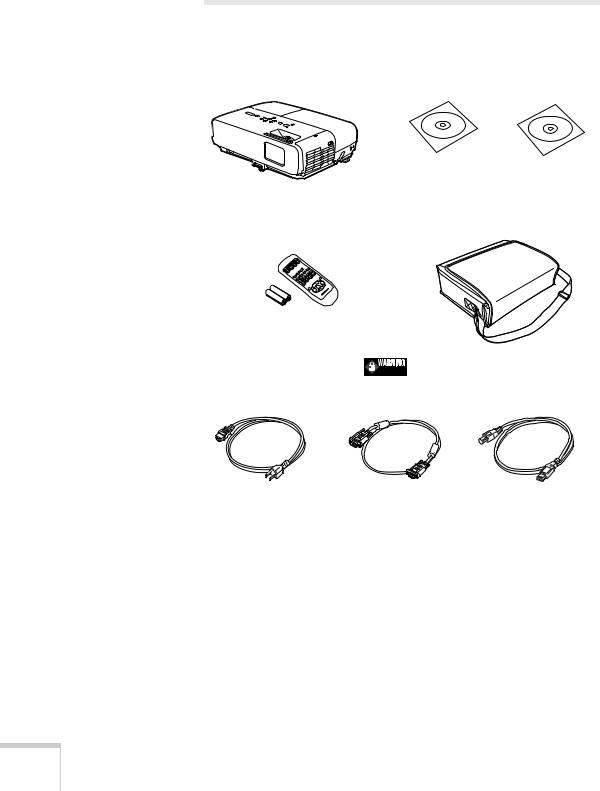
Unpacking the Projector
After unpacking the projector, make sure you have all the parts shown below:
PDF manual and |
Projector software |
registration CD-ROM |
CD-ROM |
Projector |
(84+/85+/825+/ |
|
|
|
826W+ only) |
Remote control and 2 AA batteries
Carrying case
Security sticker
Power cord |
VGA computer cable |
USB cable |
Save all packaging in case you need to ship the projector. Always use the original packaging (or the equivalent) when you need to send the projector to another location. If you are moving the projector by hand, use the carrying case. See page 129 for transportation instructions.
10 Welcome
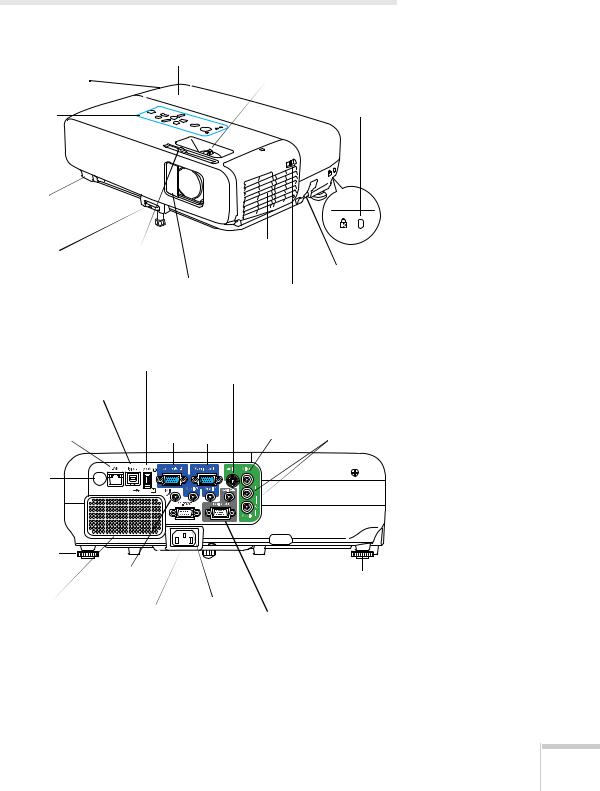
Projector Parts
Front
Lamp cover |
Focus and |
|
Air exhaust |
zoom rings |
|
vent |
||
|
Security Control 
 slot panel
slot panel
Remote |
|
|
|
|
|
|
receiver |
|
|
|
|
|
|
|
A/V mute |
|
|
Air intake vent/ |
|
|
Foot release |
|
|
Air filter |
|
Security |
|
lever |
slide lever |
|
|
|
|
bar |
|
|
A/V mute slide |
Air filter |
|
||
|
|
|
|
|
|
|
|
|
|
|
|
cover switch |
|
Back |
USB Type A port |
|
|
|
||
|
(85+/824+/825+/ |
S-Video |
|
|||
|
826W+ only) |
|
|
|||
|
|
port |
|
|
||
USB Type |
|
|
|
|
||
|
|
|
|
|
||
B port |
|
|
|
|
|
|
LAN port |
|
Computer1 |
|
Video |
Audio L-R |
|
(84+/85+/825+/ |
|
and 2 ports and |
||||
826W+ only) |
|
audio jacks |
|
port |
input jacks |
|
Remote |
|
|
|
|
|
|
receiver |
|
|
|
|
|
|
Rear |
|
|
|
|
|
|
adjustable |
|
|
|
|
|
|
foot |
Microphone |
|
|
|
|
Rear |
|
|
|
|
|
||
|
jack |
|
|
|
|
adjustable foot |
Speaker |
Power |
RS-232 |
|
|
||
|
serial port |
Monitor Out and |
||||
|
inlet |
|
||||
|
|
|
|
Audio Out ports |
||
|
|
|
|
|
||
(84+/85+/825+/ 826W+ only)
Welcome 11

Control Panel |
Adjusts Opens menu system |
|
|
|
volume |
Corrects |
|
|
|
|
|
|
Turns projector |
Keystone |
Cancel/exit |
|
|
||
|
on and off |
|
|
Indicate |
|
|
Opens help |
projector status |
|
||
|
system |
||
|
|
|
|
|
|
Adjusts |
|
|
|
volume |
|
|
Searches for |
|
|
|
source image |
Corrects |
|
|
|
Keystone |
|
Additional Components
Depending on how you plan to use the projector, you may need additional components:
■To receive an S-video signal, you’ll need an S-video cable. One may be provided with your video equipment, or you can purchase one from Epson; see the list on page 13.
■To receive a component video signal from a DVD player or other video device, you’ll need an component-to-VGA video cable. You can purchase one from Epson; see the list on page 13.
■To play sound through your projector you will need an audio cable. One may be provided with your equipment, or you can purchase one from an electronics store.
12 Welcome

Optional Accessories
To enhance your use of the projector, Epson provides the following optional accessories:
Product |
Part number |
|
|
Genuine Epson projector lamp |
V13H010L50 |
|
|
Air filter replacement set (2 filters) |
V13H134A22 |
|
|
DC-10s document camera |
ELPDC10S |
|
|
DC-06 document camera |
V12H321001 |
|
|
Wireless 802.11a/b/g Module |
V12H306P11 |
(PowerLite 85+/825+/826W+ only) |
|
|
|
Quick Wireless Connection USB key (ELPAP05) |
V12H005M05 |
(PowerLite 85+/825+/826W+ only) |
|
|
|
Wheeled soft carrying case |
ELPKS62 |
Soft shoulder carrying case |
ELPKS61 |
Molded hard shell wheeled carrying case |
ELPKS58 |
SwissGear® backpack |
ELPKS63 |
Universal projector ceiling mount |
ELPMBPJF |
Advanced projector ceiling mount |
ELPMBPRG |
High security projector ceiling mount |
ELPMBATA |
Adjustable suspended ceiling channel kit |
ELPMBP01 |
Suspended false ceiling plate kit |
ELPMBP02 |
Structural round ceiling plate |
ELPMBP03 |
Adjustable extension column, 8 to 11 inches |
ELPMBC01 |
|
|
Kensington® MicroSaver® security lock |
ELPSL01 |
Duet™ portable projector screen |
ELPSC80 |
50-inch portable screen (4:3 aspect ratio) |
ELPSC06 |
80-inch portable pop-up screen (4:3 aspect ratio) |
ELPSC08 |
|
|
Component-to-VGA video cable |
ELPKC19 |
S-Video cable |
ELPSV01 |
|
|
Distribution amplifier |
ELPDA01 |
|
|
AP-60 Projector Sound Solution |
V12H329020 |
|
|
You can purchase screens, carrying cases, or other accessories from an Epson authorized reseller. To find the nearest reseller, call 800-GO-EPSON (800-463-7766). Or you can purchase online at www.epsonstore.com (U.S. sales) or www.epson.ca (Canadian sales).
Welcome 13

14 Welcome

1Displayingthe Image and Adjusting
Whether you’re presenting from a computer or video equipment, you need to follow some basic steps to display your image on the screen.
Follow the guidelines in this chapter for:
■Positioning the projector
■Turning the projector on and off
■Selecting the image source
■Adjusting the image
15
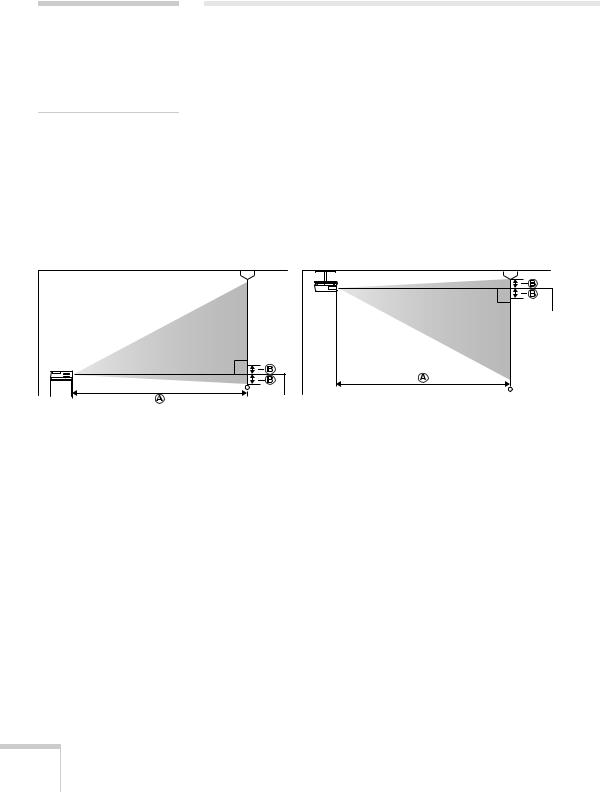
note
You can mount the projector on the ceiling, or place it behind a translucent screen for rear projection. See page 151 for details.
Positioning the Projector
If the projector isn’t already installed in the room you’re using, you’ll probably want to place it on a table in front of the screen. This lets you stand in the front of the room, face the audience, and remain close enough to the equipment to be able to control it. Try to leave as much space as possible between the projector and the screen to get a good-size image.
Use the illustrations and tables below to help you determine placement. Image size increases with distance, but can vary depending on how you position the zoom ring and whether you’ve adjusted the image with other settings.
You can also use the Image Size Calculator on the Epson website.
Center of |
lens |
Center of lens
PowerLite 84+/85+/824+/825+ (4:3 images)
|
Projection distance (A) |
|
Screen size |
Wide to Tele |
Offset (B) |
|
|
|
30 inches |
33 to 54 inches |
-1.8 inches |
|
(83 to 136 cm) |
(-5 cm) |
|
|
|
40 inches |
44 to 72 inches |
-2.5 inches |
|
(111 to 182 cm) |
(-6 cm) |
|
|
|
50 inches |
55 to 90 inches |
-3.1 inches |
|
(140 to 229 cm) |
(-8 cm) |
|
|
|
60 inches |
66 to 108 inches |
-3.7 inches |
|
(169 to 275 cm) |
(-9 cm) |
|
|
|
80 inches |
89 to 145 inches |
-4.9 inches |
|
(226 to 368 cm) |
(-13 cm) |
|
|
|
16 Displaying and Adjusting the Image

|
Projection distance (A) |
|
Screen size |
Wide to Tele |
Offset (B) |
|
|
|
100 inches |
111 to 181 inches |
-6.2 inches |
|
(283 to 460 cm) |
(-16 cm) |
|
|
|
150 inches |
168 to 272 inches |
-9.2 inches |
|
(426 to 692 cm) |
(-23 cm) |
|
|
|
200 inches |
224 to 363 inches |
-12.3 inches |
|
(568 to 923 cm) |
(-31 cm) |
|
|
|
250 inches |
280 to 455 inches |
-15.4 inches |
|
(711 to 1155 cm) |
(-39 cm) |
|
|
|
300 inches |
336 to 546 inches |
-18.5 inches |
|
(854 to 1386 cm) |
(-47 cm) |
|
|
|
PowerLite 84+/85+/824+/825+ (16:9 images)
|
Projection distance (A) |
|
Screen size |
Wide to Tele |
Offset (B) |
|
|
|
28 inches |
33 to 55 inches |
0.4 inches |
|
(84 to 138 cm) |
(1 cm) |
|
|
|
30 inches |
36 to 58 inches |
0.4 inches |
|
(91 to 149 cm) |
(1 cm) |
|
|
|
40 inches |
48 to 78 inches |
0.6 inches |
|
(122 to 199 cm) |
(1 cm) |
|
|
|
50 inches |
60 to 98 inches |
0.7 inches |
|
(153 to 249 cm) |
(2 cm) |
|
|
|
60 inches |
72 to 118 inches |
0.9 inches |
|
(184 to 300 cm) |
(2 cm) |
|
|
|
80 inches |
97 to 158 inches |
1.2 inches |
|
(246 to 401 cm) |
(3 cm) |
|
|
|
100 inches |
121 to 197 inches |
1.5 inches |
|
(308 to 502 cm) |
(4 cm) |
|
|
|
Displaying and Adjusting the Image 17

|
Projection distance (A) |
|
Screen size |
Wide to Tele |
Offset (B) |
|
|
|
150 inches |
183 to 297 inches |
2.2 inches |
|
(464 to 754 cm) |
(6 cm) |
|
|
|
200 inches |
244 to 396 inches |
2.9 inches |
|
(619 to 1006 cm) |
(7 cm) |
|
|
|
250 inches |
305 to 495 inches |
3.7 inches |
|
(775 to 1258 cm) |
(9 cm) |
|
|
|
275 inches |
336 to 545 inches |
4 inches |
|
(853 to 1384 cm) |
(10 cm) |
|
|
|
PowerLite 84+/85+/824+/825+ (16:10 images)
|
Projection distance (A) |
|
Screen size |
Wide to Tele |
Offset (B) |
|
|
|
29 inches |
33 to 55 inches |
-0.4 inches |
|
(85 to 140 cm) |
(-1 cm) |
|
|
|
40 inches |
47 to 76 inches |
-0.5 inches |
|
(118 to 193 cm) |
(-1 cm) |
|
|
|
50 inches |
58 to 95 inches |
-0.6 inches |
|
(149 to 243 cm) |
(-2 cm) |
|
|
|
60 inches |
70 to 115 inches |
-0.7 inches |
|
(179 to 292 cm) |
(-2 cm) |
|
|
|
70 inches |
82 to 134 inches |
-0.9 inches |
|
(209 to 341 cm) |
(-2 cm) |
|
|
|
80 inches |
94 to 153 inches |
-1 inches |
|
(239 to 390 cm) |
(-2 cm) |
|
|
|
100 inches |
118 to 192 inches |
-1.2 inches |
|
(300 to 488 cm) |
(-3 cm) |
|
|
|
150 inches |
178 to 289 inches |
-1.8 inches |
|
(451 to 733 cm) |
(-5 cm) |
|
|
|
200 inches |
237 to 385 inches |
-2.5 inches |
|
(603 to 979 cm) |
(-6 cm) |
|
|
|
250 inches |
297 to 482 inches |
-3.1 inches |
|
(754 to 1224 cm) |
(-8 cm) |
|
|
|
280 inches |
333 to 540 inches |
-3.4 inches |
|
(845 to 1371 cm) |
(-9 cm) |
|
|
|
18 Displaying and Adjusting the Image

PowerLite 826W+ (16:10 images)
|
Projection distance (A) |
|
Screen size |
Wide to Tele |
Offset (B) |
|
|
|
30 inches |
35 to 57 inches |
-0.4 inches |
|
(88 to 144 cm) |
(-1 cm) |
|
|
|
40 inches |
47 to 76 inches |
-0.5 inches |
|
(118 to 193 cm) |
(-1 cm) |
|
|
|
50 inches |
58 to 95 inches |
-0.6 inches |
|
(149 to 243 cm) |
(-2 cm) |
|
|
|
60 inches |
70 to 115 inches |
-0.7 inches |
|
(179 to 292 cm) |
(-2 cm) |
|
|
|
80 inches |
94 to 153 inches |
-1 inches |
|
(239 to 390 cm) |
(-2 cm) |
|
|
|
100 inches |
118 to 192 inches |
-1.2 inches |
|
(300 to 488 cm) |
(-3 cm) |
|
|
|
150 inches |
178 to 289 inches |
-1.8 inches |
|
(451 to 733 cm) |
(-5 cm) |
|
|
|
200 inches |
237 to 385 inches |
-2.5 inches |
|
(603 to 979 cm) |
(-6 cm) |
|
|
|
250 inches |
297 to 482 inches |
-3.1 inches |
|
(754 to 1224 cm) |
(-8 cm) |
|
|
|
280 inches |
333 to 540 inches |
-3.4 inches |
|
(845 to 1371 cm) |
(-9 cm) |
|
|
|
PowerLite 826W+ (4:3 images)
|
Projection distance (A) |
|
Screen size |
Wide to Tele |
Offset (B) |
|
|
|
25 inches |
33 to 54 inches |
-0.3 inches |
|
(83 to 136 cm) |
(-1 cm) |
|
|
|
30 inches |
39 to 65 inches |
-0.4 inches |
|
(100 to 164 cm) |
(-1 cm) |
|
|
|
40 inches |
53 to 86 inches |
-0.6 inches |
|
(134 to 219 cm) |
(-1 cm) |
|
|
|
50 inches |
66 to 108 inches |
-0.7 inches |
|
(169 to 275 cm) |
(-2 cm) |
|
|
|
Displaying and Adjusting the Image 19

|
Projection distance (A) |
|
Screen size |
Wide to Tele |
Offset (B) |
|
|
|
60 inches |
80 to 130 inches |
-0.8 inches |
|
(203 to 331 cm) |
(-2 cm) |
|
|
|
80 inches |
107 to 174 inches |
-1.1 inches |
|
(271 to 442 cm) |
(-3 cm) |
|
|
|
100 inches |
134 to 218 inches |
-1.4 inches |
|
(340 to 553 cm) |
(-4 cm) |
|
|
|
120 inches |
161 to 261 inches |
-1.7 inches |
|
(408 to 664 cm) |
(-4 cm) |
|
|
|
150 inches |
201 to 327 inches |
-2.1 inches |
|
(511 to 831 cm) |
(-5 cm) |
|
|
|
200 inches |
269 to 436 inches |
-2.8 inches |
|
(682 to 1108 cm) |
(-7 cm) |
|
|
|
250 inches |
336 to 546 inches |
-3.5 inches |
|
(854 to 1386 cm) |
(-9 cm) |
|
|
|
PowerLite 826W+ (16:9 images)
|
Projection distance (A) |
|
Screen size |
Wide to Tele |
Offset (B) |
|
|
|
28 inches |
33 to 55 inches |
0.4 inches |
|
(84 to 138 cm) |
(1 cm) |
|
|
|
30 inches |
36 to 58 inches |
0.4 inches |
|
(91 to 149 cm) |
(1 cm) |
|
|
|
40 inches |
48 to 78 inches |
0.6 inches |
|
(122 to 199 cm) |
(1 cm) |
|
|
|
50 inches |
60 to 98 inches |
0.7 inches |
|
(153 to 249 cm) |
(2 cm) |
|
|
|
60 inches |
72 to 118 inches |
0.9 inches |
|
(184 to 300 cm) |
(2 cm) |
|
|
|
80 inches |
97 to 158 inches |
1.2 inches |
|
(246 to 401 cm) |
(3 cm) |
|
|
|
100 inches |
121 to 197 inches |
1.5 inches |
|
(308 to 502 cm) |
(4 cm) |
|
|
|
20 Displaying and Adjusting the Image
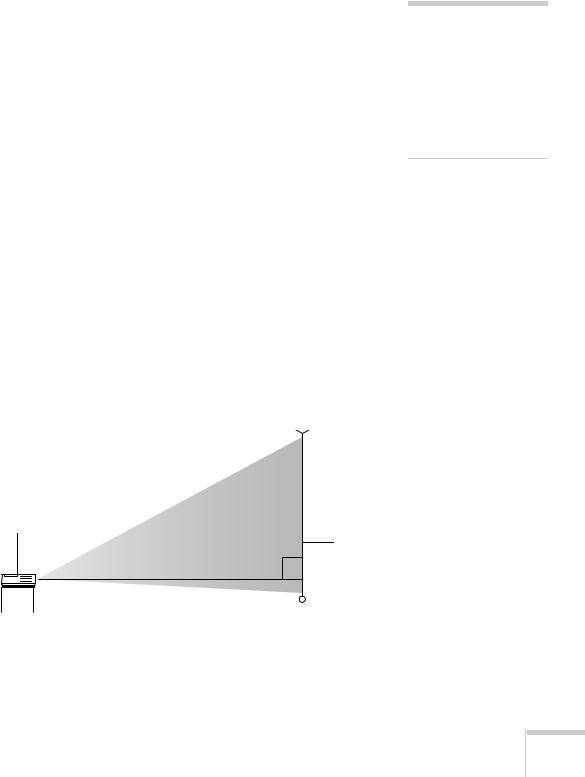
|
Projection distance (A) |
|
Screen size |
Wide to Tele |
Offset (B) |
|
|
|
150 inches |
183 to 297 inches |
2.2 inches |
|
(464 to 754 cm) |
(6 cm) |
|
|
|
200 inches |
244 to 396 inches |
2.9 inches |
|
(619 to 1006 cm) |
(7 cm) |
|
|
|
250 inches |
305 to 495 inches |
3.7 inches |
|
(775 to 1258 cm) |
(9 cm) |
|
|
|
275 inches |
853 to 1384 inches |
4 inches |
|
(83 to 136 cm) |
(10 cm) |
|
|
|
Also keep these considerations in mind:
■Place the projector on a sturdy, level surface.
■Make sure there is plenty of space for ventilation around and under the projector.
■Make sure the projector is within 9 feet (2.7 meters) (PowerLite 84+/85+/825+/826W+) or 5 feet (1.5 meters) (PowerLite 824+) of a grounded electrical outlet or extension cord.
Ideally, you should place the projector directly in front of the center of the screen, facing it toward the screen squarely. The base of the lens should be at about the level of the bottom of the screen.
note
After positioning the projector, you may want to connect a Kensington MicroSaver® anti-theft device to the lock port on the projector. You can purchase this from Epson; see
page 13.
Projector
Screen
Displaying and Adjusting the Image 21

If you place the projector below screen level, you’ll have to tilt it up by extending the front adjustable foot. This causes the image to become “keystone” shaped, but you can correct the distortion by pressing the buttons on the projector. See page 28 for detailed information about correcting the image shape.
For instructions on installing the projector in a permanent location, such as a theater or conference room, see page 151.
Turning the Projector On and Off
Make sure your projector and any computer or video equipment are connected as described on page 47. Turn on your connected equipment before starting the projector so it can automatically detect and display the image source. If you turn on the projector first, or have multiple pieces of connected equipment, you may have to select the image source manually (see page 25).
22 Displaying and Adjusting the Image
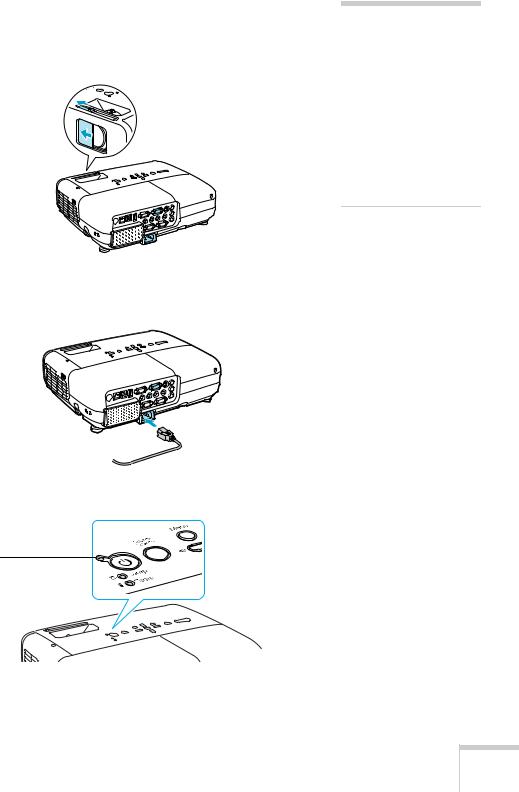
Turning On the Projector
Follow these steps to turn on the projector:
1. Open the A/V Mute slide (lens cover).
2.Plug one end of the power cable into the projector, and the other end into an electrical outlet.
The P power light turns orange.
Power light
note
You can set the projector to automatically turn off the lamp and enter “sleep mode” when it has not received any signals or the A/V Mute slide remains closed for a period of time. This conserves electricity, cools the projector, and extends the life of the lamp. To enable sleep mode, see page 117.
Displaying and Adjusting the Image 23
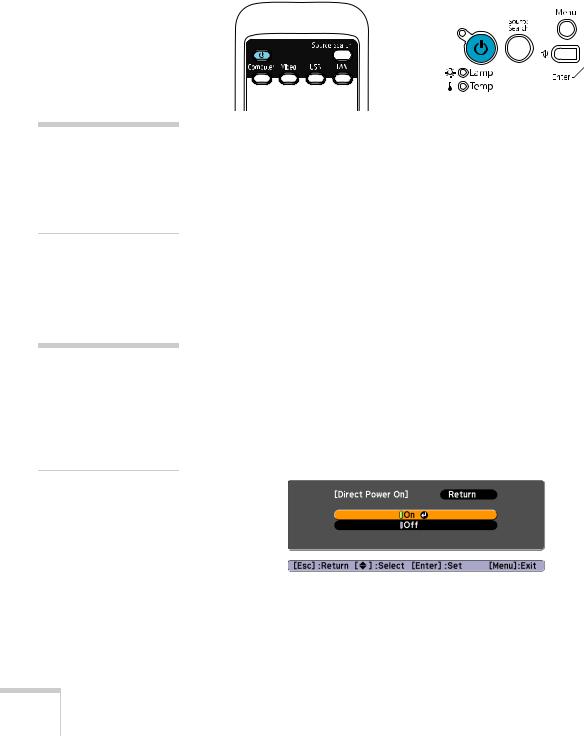
warning
Never look into the lens when the lamp is on. This can damage your eyes, and is especially dangerous for children and pets.
3.Press the P power button on the remote control or on top of the projector.
The projector beeps once and the P power light flashes green as the projector warms up, then an image begins to appear. When the P power light stops flashing and remains green, the projector is ready for use.
4. If you are prompted to enter a password, see page 111.
note
If a power outage occurs when Direct Power On is enabled and the projector is plugged in, the projector will restart when the power is restored.
Using the Direct Power On Function
The Direct Power On function enables faster setup. The projector will start up automatically when you plug it in; you won’t have to press the P power button.
Follow these steps to enable Direct Power On:
1.Press the Menu button on the remote control and select the
Extended menu.
2.Choose Operation and press Enter.
3.Choose Direct Power On and press Enter.
4.Highlight On and press Enter.
5.Press Esc or Menu to exit. The setting will take effect the next time you plug in the projector.
24 Displaying and Adjusting the Image
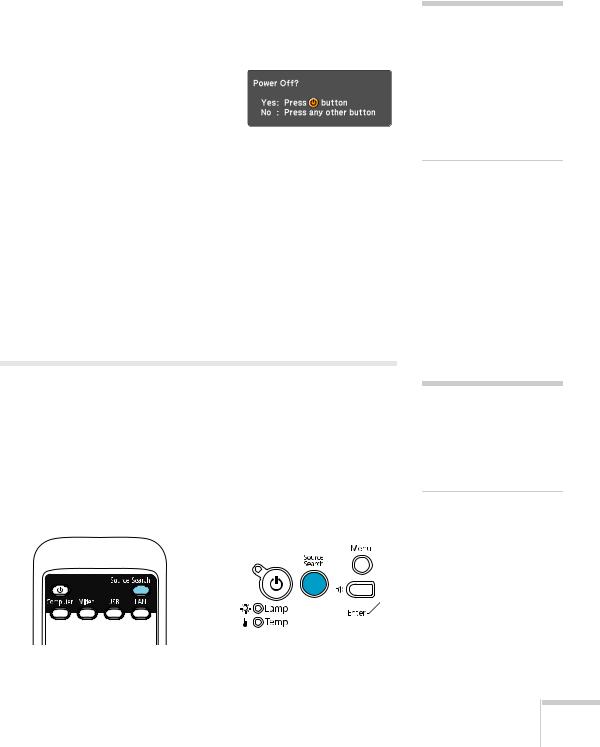
Shutting Down the Projector
This projector incorporates Instant Off technology. To turn the projector off, you can press its P power button as described below, or turn off a power switch that supplies power to the projector. You don’t have to wait for the projector to cool off first.
1.To turn off the projector, press the P power button on the remote control or projector.
You see a confirmation message.
(If you don’t want to turn it off, press any other button.)
2.Press the P power button again. When the P power light stops flashing and you hear two beeps, unplug the power cord.
If you want to turn the projector on again, make sure the orange P power light is not flashing, then press the P power button.
3.If you extended the adjustable front foot, press up on the foot release lever to retract it.
4.Close the A/V Mute slide.
note
Lamp life results will vary depending on mode selected, environmental conditions, and usage.
Turn off this product when not in use to prolong the life of the projector.
Selecting the Image Source
Selecting the image source lets you switch between images input from different pieces of connected equipment (such as a computer or DVD player).
If you don’t see the image you want, press the Source Search button on the remote control or projector until you see the image you want to project.
note
To focus and adjust the image, see page 26. If a projected image fails to appear, see page 136 for help.
Displaying and Adjusting the Image 25

You can also use the Computer, Video, and USB buttons on the remote control to switch between devices connected to the ports identified on each button, or select LAN to project through your network (the LAN button does not work with the PowerLite 84+ or 824+). See page 33 for more information.
Adjusting the Image
Once you see your image, you need to make certain adjustments:
■If the image is too high or too low, you can reposition it. See page 27.
■
■
■
■
To focus or zoom your image, see page 27.
If the image isn’t square, see page 28.
If a computer image displays incorrectly, see page 30.
If you need to fine-tune the image and/or sound, see page 101.
26 Displaying and Adjusting the Image
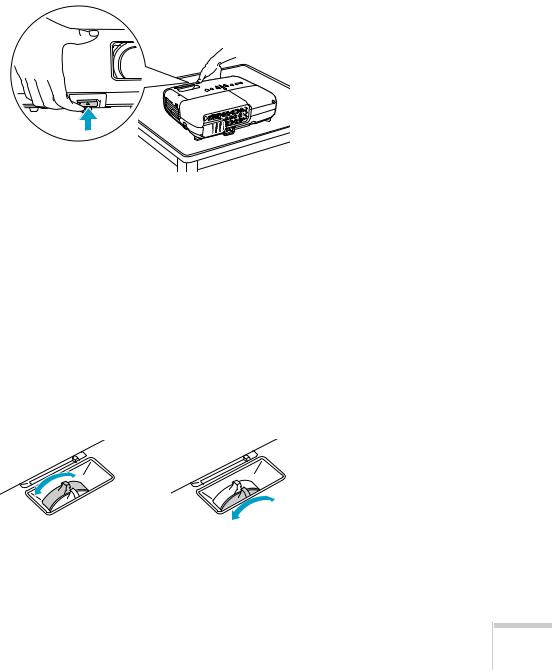
Adjusting the Height of Your Image
If the image is too low on the screen, you can use the front adjustable foot to raise it.
1.Stand behind the projector. Press the foot release lever up and lift the front of the projector.
2.Once the image is positioned where you want it, release the lever to lock the foot in position.
3.If necessary, you can fine-tune the height or level of the image by turning the projector’s adjustable rear feet.
Raising the projector causes the image to distort or “keystone,” but you can correct the shape as described on page 28.
Focusing and Zooming Your Image
Turn the focus ring on the projector to sharpen the image.
Turn the zoom ring on the projector to reduce or enlarge the image.
Focus |
Zoom |
Displaying and Adjusting the Image 27
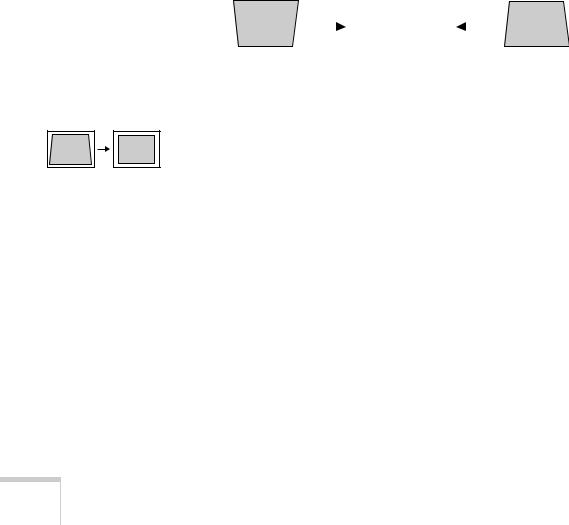
If the image still isn’t large enough, you may need to move the projector farther away from the screen. You can also use the E-Zoom buttons on the remote control to zoom in on a portion of the image. See page 35 for instructions.
Adjusting the Image Shape
In most cases, you can maintain a square or rectangular image by placing the projector directly in front of the center of the screen with the base of the lens level with the bottom of the screen.
Even if the projector is slightly tilted (within a range of 30° up or down), the projector has an automatic keystone correction function that detects and corrects vertical keystone distortion.
|
|
|
|
|
|
|
|
|
|
|
|
|
|
|
|
|
|
|
|
|
|
|
|
|
|
|
|
|
|
|
|
|
|
|
|
|
|
|
|
|
|
|
|
|
|
|
|
|
|
|
|
Projector tilted up |
|
|
Corrected image |
Projector tilted down |
||||||||
Keystone correction
It takes about one second after projection starts for the image to be corrected. During this time, a vertical keystone correction gauge appears on the screen.
If your image is still distorted, you can correct it using the Keystone buttons on the projector’s control panel or the projector’s Setting menu.
28 Displaying and Adjusting the Image
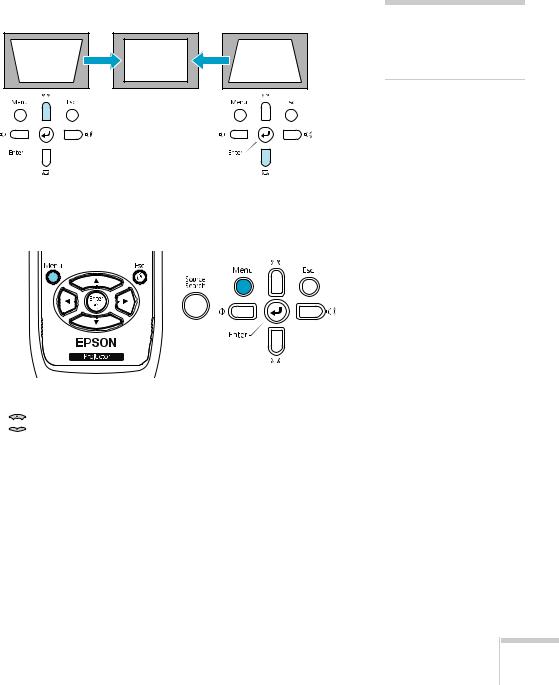
Using Keystone Correction
To adjust your image when it is wider on the top or bottom, do the following:
■Press one of the two keystone correction buttons on the projector’s control panel, as shown below. Continue pressing the button until you are satisfied with the shape of the image.
■Or press the Menu button on the remote control or projector, select the Settings menu, and press Enter.
From the Settings menu, select Keystone and press Enter. Use the 
 pointer buttons on the remote control to adjust the keystone setting as needed.
pointer buttons on the remote control to adjust the keystone setting as needed.
If the image quality declines (for example, lines or edges look jagged), reduce the sharpness setting. See page 105.
tip
You can display a test pattern to help align the image (see page 109).
Displaying and Adjusting the Image 29
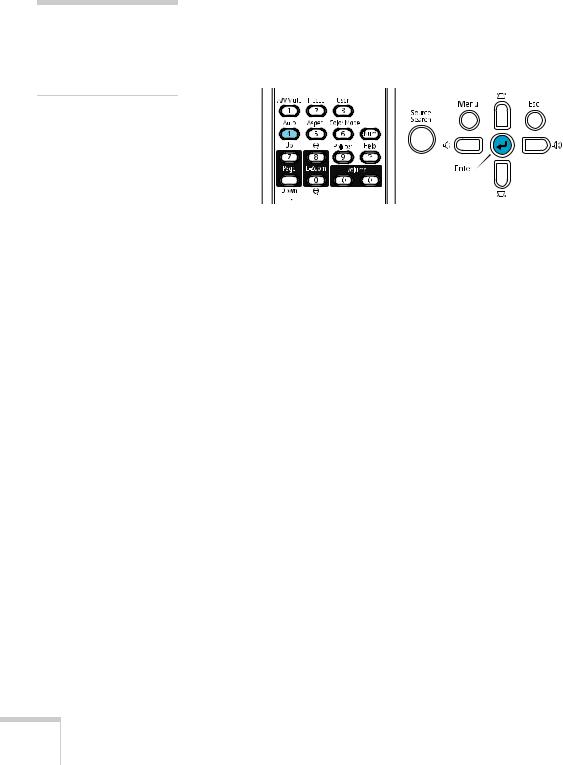
note
The Auto button works only with computer images projected through the VGA port.
Correcting Computer Images
If you’re connected to a computer and the image doesn’t look right, press the Auto button on the remote control or the Enter button on the projector. This automatically resets the projector’s tracking, sync, resolution, and position settings.
If the Auto button doesn’t correct the problem, you may need to adjust the tracking or sync using the projector’s Signal menu. See page 106 for more information.
30 Displaying and Adjusting the Image
